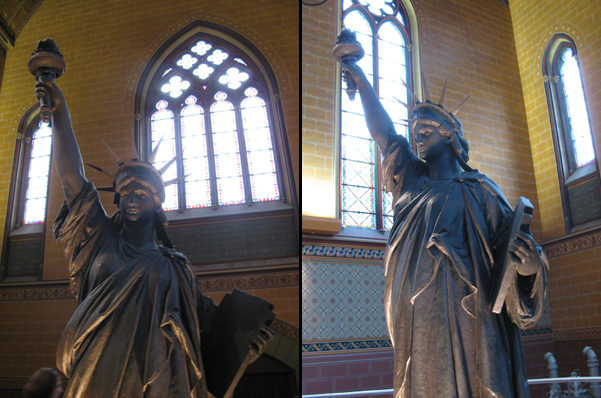
Execution model of the Statue of Liberty, Musee des Arts et Metiers. Photos GLK
France Revisited celebrates the Fourth of July with a photo reportage of the major Statues of Liberty in Paris, along with the author’s homegrown version.
The image above shows the original 1/16th plaster execution model of Auguste Bartholdi’s statue La Liberté éclairant le monde (Liberty Enlightening the World) better known as The Statue of Liberty. It’s presented at the far end of a former chapel built in the 12th-century within the complex of the Musée des Arts et Métiers, the National Museum of Technical Innovation, which is among the most underrated of the major museums of Paris.
That model was used to create the larger scale models and eventually the finished plaster model on which copper sheets were then molded in Paris. The sheets were then disassembled, shipped to New York Harbor, and reassembled on a metal frame created by Gustave Eiffel’s engineering company, shortly before Eiffel got to work on his famous tower.
Built in Paris between 1875 and 1884, the Statue of Liberty was erected in New York Harbor in 1886, a gift from France on the occasion of the centennial of the independence of the United States.
In June 2011, American Ambassador Charles H. Rivkin was on hand to inaugurate a new bronze cast made from the execution model above. The ambassador gave his official speech about French-American friendship while inside the former chapel, with the execution model in the background.

The new bronze cast, however, is located outside the museum. Why a new bronze cast should be worthy of much attention when the more significant model already exists inside I don’t know.
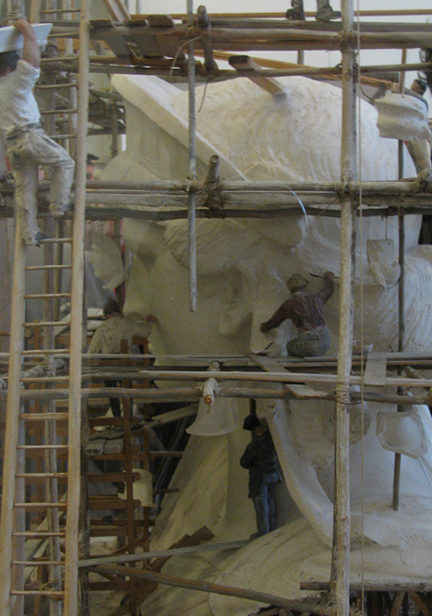 A small exhibit in the museum presents models and photos showing how the statue was originally enlarged and built, as in this scale model showing the creation of the plaster head over a wooden frame.
A small exhibit in the museum presents models and photos showing how the statue was originally enlarged and built, as in this scale model showing the creation of the plaster head over a wooden frame.
A full-size plaster ear and other Liberty models are found in the Bartholdi Museum in the sculptor’s home in Colmar in Alsace in eastern France.
A gilt reproduction of Liberty’s flame, a gift to Paris from the American Chamber of Commerce, stands by the Pont de l’Alma, two bridges upstream from the Eiffel Tower. For a time the flame was less associated with liberty than with Princess Diana, that other candle in the wind, since it was in the tunnel below that she was mortally wounded in a car crash against a pillar. The trace of something square on the right side of this photo is a trace of a photo of the princess after it was removed.
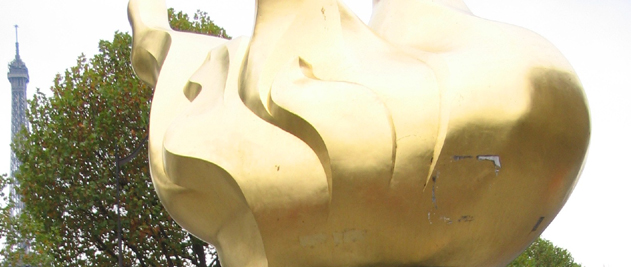
More dramatically situated is the 1/8th scale statue on Ile aux Cygnes, a narrow artificial island in the Seine. A gift to the City of Paris from the French community living in the United States, it was placed here in 1889, the same year that the Eiffel Tower was completed, on the occasion of the centennial of the French Revolution.
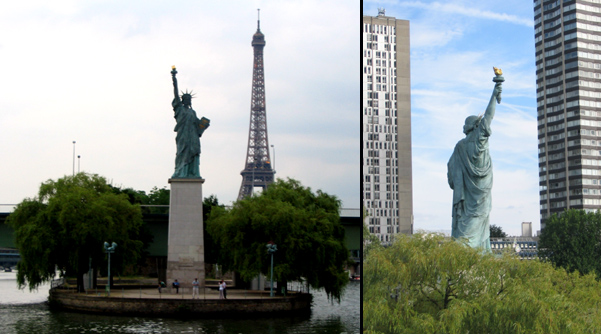
Originally this Liberty faced Paris and the Eiffel Tower, but in 1937 she was turned around so as to face New York.
Liberty’s tablet, which in New York reads “JULY IV MDCCLXXVI,” here reads “IV JUILLET 1776 = XIV JUILLET 1789,” i.e. the dates associated with the respective start of the American and the French Revolutions.
Here is an evocative greeting to that Liberty from France Revisited’s barefoot photographer Va-nu-pieds.
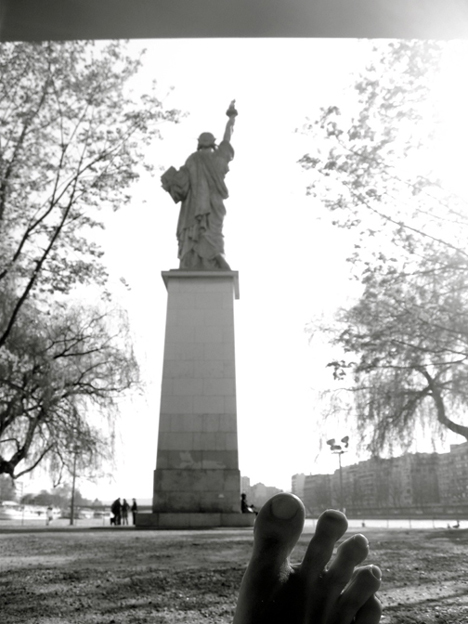
Va-nu-pied’s photo of another monument created by Auguste Bartoldi can be seen here.
The most accessible of the Statues of Liberty of Paris is in the western side of the Luxembourg Garden. [Post-note: Several months after this article was intially posted the Luxembourg version was removed from its pedestal for restoration before being inaugurated in his now home at the Orsay Museum in July 2012. A new copy is being cast to replace it in the garden.]
This bronze 1/16th scale reproduction, shown at the Paris World’s Fair of 1900, was a gift from the sculptor to the Luxembourg Museum, subsequently moved outside. This Liberty’s tablet is inscribed with the date 15 DE NOVEMBRE 1889, which is the date on which the version above was inaugurated. Again, the honors go to Va-nu-pieds.
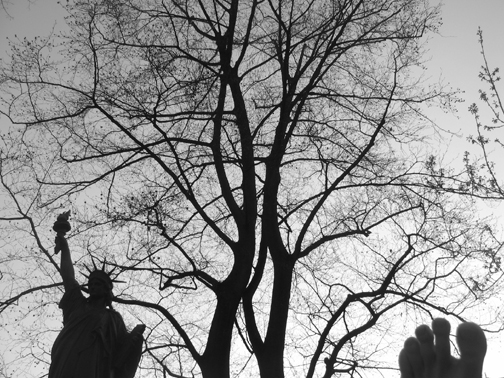
An American oak, a gift of the American community in Paris, is planted beside the statue in memory of the victims of 9/11.
Overall, Parisians have the opportunity to get up close and personal with the Statue of Liberty more than most Americans. But I recently brought to Paris a version that few, if any, Parisians had ever seen: a Chia Statue of Liberty.
Here she is feeling the heat on my balcony on July 1 after I’ve been away for two days.
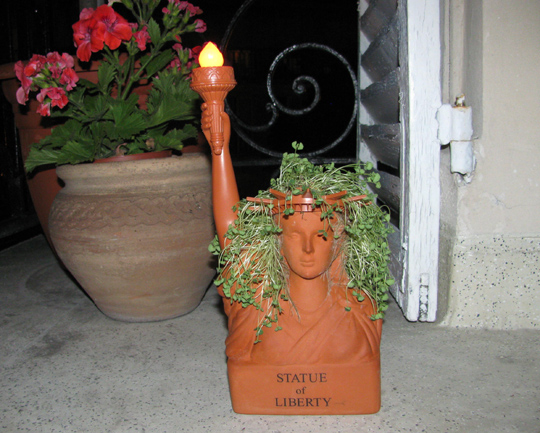
And here she is in full bloom on the 4th of July.
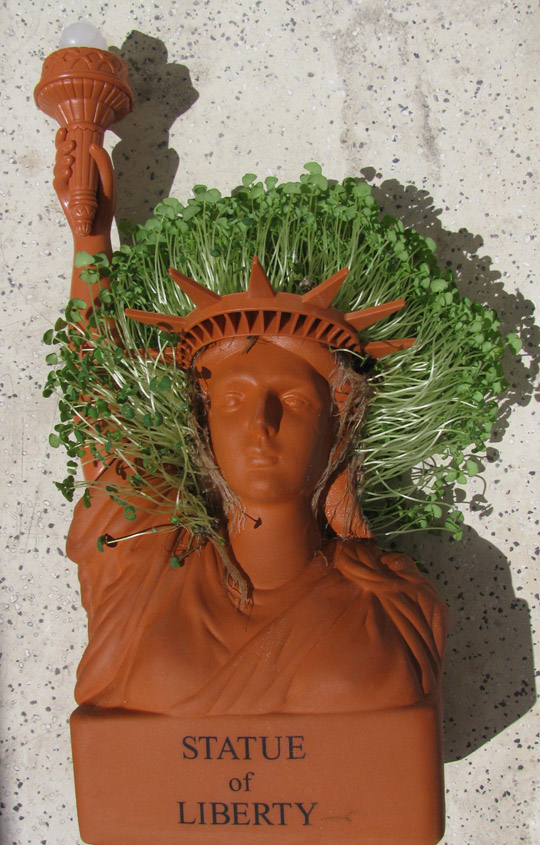
Happy Fourth of July!
(c) 2011, Gary Lee Kraut
Also see Lafayette and the American Flag: The Fourth of July Ceremony in Paris.


most enlightening
Terrific insight on July 4th – We have seen many of the statues located outdoors; I had forgotten the coincidence of the location of the flame to the tunnel.